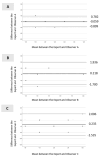Validation of Binocular Vision and Ocular Surface Assessment Tools in Digital Eye Strain Syndrome: The DESIROUS Study
- PMID: 40423040
- PMCID: PMC12112993
- DOI: 10.3390/jpm15050168
Validation of Binocular Vision and Ocular Surface Assessment Tools in Digital Eye Strain Syndrome: The DESIROUS Study
Abstract
Background: To understand if binocular vision disorders are associated with Digital Eye Strain Syndrome (DESS), a study protocol is needed to ensure consistency across observational studies. This study aims to test the feasibility of a protocol to assess DESS, screen time, binocular vision, and dry eye. Methods: DESIROUS is an observational cross-sectional study among Polytechnic students at the Lisbon School of Health Technology, Portugal. The protocol includes three questionnaires (Computer Vision Syndrome Questionnaire [CVS-Q], Convergence Insufficiency Symptom Survey [CISS], and Dry Eye Questionnaire version 5 [DEQ-5]), an assessment of visual acuity and binocular vision (cover test for near and distance, stereopsis, near point convergence (NPC), near point accommodation (NPA), accommodative facility, vergence), and the ocular surface break-up tear (BUT) test. The questionnaires were validated using Cronbach's alpha. Interobserver variability for BUT was assessed using Cohen's Kappa, Intraclass Correlation Coefficient (ICC), and Bland-Altman analysis involving three observers (A, B, and C), compared against an expert as the gold standard. Results: A total of 18 students were included in the validation phase (mean age: 21.50 ± 0.62 years; females: 77.8%). The internal consistency of the CVS-Q (α = 0.773) and the CISS (α = 0.756) was considered good, while the DEQ-5 showed a reasonable internal consistency (α = 0.594). Observer A had the highest agreement with the gold standard (Cohen's Kappa = 0.710 and p < 0.001; ICC = 0.924, p < 0.001). Conclusions: We provide a protocol to assess binocular vision and the ocular surface, with an emphasis on objective measures while integrating other assessment approaches. Further studies are necessary to validate this protocol, potentially incorporating new measures to enhance its validity across different populations.
Keywords: accommodation; binocular vision; convergence; digital eye strain; ocular surface.
Conflict of interest statement
C.L. reports personal fees from Eyerising International outside the submitted work. A.G. reports personal fees from Thea, Nevakar, Zeiss, and Eyerising and grants from Essilor and CooperVision outside the submitted work. M.J.B., P.A., and A.M.-R. declare that they do not have competing interests.
Figures



Similar articles
-
The effects of breaks on digital eye strain, dry eye and binocular vision: Testing the 20-20-20 rule.Cont Lens Anterior Eye. 2023 Apr;46(2):101744. doi: 10.1016/j.clae.2022.101744. Epub 2022 Aug 11. Cont Lens Anterior Eye. 2023. PMID: 35963776
-
Binocular vision anomalies and normative data (BAND) in Tamil Nadu: report 1.Clin Exp Optom. 2017 May;100(3):278-284. doi: 10.1111/cxo.12475. Epub 2016 Oct 30. Clin Exp Optom. 2017. PMID: 27796049
-
Accommodative and binocular disorders in preteens with computer vision syndrome: a cross-sectional study.Ann N Y Acad Sci. 2021 May;1492(1):73-81. doi: 10.1111/nyas.14553. Epub 2020 Dec 30. Ann N Y Acad Sci. 2021. PMID: 33377551
-
Diagnostic Protocol for Accommodative and Vergence Anomalies - A Review.J Binocul Vis Ocul Motil. 2024 Apr-Jun;74(2):48-64. doi: 10.1080/2576117X.2024.2347663. Epub 2024 Jun 20. J Binocul Vis Ocul Motil. 2024. PMID: 38899986 Review.
-
Ocular and visual discomfort associated with smartphones, tablets and computers: what we do and do not know.Clin Exp Optom. 2019 Sep;102(5):463-477. doi: 10.1111/cxo.12851. Epub 2019 Jan 21. Clin Exp Optom. 2019. PMID: 30663136 Review.
References
-
- Seresirikachorn K., Thiamthat W., Sriyuttagrai W., Soonthornworasiri N., Singhanetr P., Yudtanahiran N., Theeramunkong T. Effects of digital devices and online learning on computer vision syndrome in students during the COVID-19 era: An online questionnaire study. BMJ Paediatr. Open. 2022;6:e001429. doi: 10.1136/bmjpo-2022-001429. - DOI - PMC - PubMed
LinkOut - more resources
Full Text Sources

